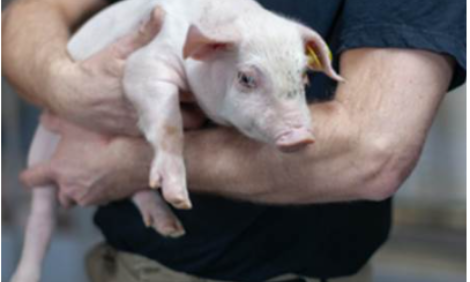



Effect of Particle Size in Calcium Carbonate on Digestibility and Retention of Calcium by Growing Pigs
Particle size does not affect calcium retention or digestibility in growing pigs, according to researchers at the Hans H. Stein Monogastric Nutrition Laboratory.Particle size is an important consideration for some feed ingredients in pig diets. Reducing the particle size of cereal grains and soybean meal in diets fed to pigs improves digestibility of energy, amino acids and other nutrients, because feed ground to smaller particle sizes has more surface area on which digestive enzymes can work.
The particle size of inorganic calcium sources has been shown to affect calcium retention in poultry. Particle sizes of 1.00mm or greater are recommended to optimise calcium retention and eggshell quality in laying hens but coarse particle sizes result in reduced calcium retention in broiler chicks.
However, little is known about the effect of particle size of calcium sources fed to pigs. Therefore, researchers at the Hans H. Stein Monogastric Nutrition Laboratory at the University of Illinois at Urbana-Champaign conducted an experiment to test different particle sizes of calcium carbonate and determine which size optimises calcium digestibility and retention by growing pigs.
Experimental Design
Forty growing barrows with an average initial body weight of 15.42kg were fed one of five diets based on corn and potato protein isolate. One diet was calcium-free, and was used to estimate basal endogenous losses of calcium. The other four diets contained supplemental calcium carbonate ground to four different particle sizes (approximately 200, 500, 750 and 1125 microns). The four experimental diets were formulated to contain identical amounts of calcium.
No significant differences were observed among the four diets for calcium retention, ATTD of calcium, or STTD of calcium (Table 1).
| Table 1. Apparent (ATTD) and standardised total tract digestibility (STTD) of calcium in diets containing four different particle sizes of calcium carbonate fed to weanling pigs |
||||||
| Particle size | ||||||
|---|---|---|---|---|---|---|
| Response variable | 200 | 500 | 750 | 1,125 | SE | P-value |
| Calcium in faeces, % | 2.07 | 1.97 | 2.09 | 1.97 | 0.15 | 0.91 |
| Calcium intake, g/day | 4.17 b | 4.52 ab | 5.04 ab | 5.34 a | 0.27 | 0.02 |
| Calcium output, g/d | 1.24 | 1.17 | 1.46 | 1.49 | 0.14 | 0.28 |
| Calcium in urine, g/day | 0.29 | 0.36 | 0.52 | 0.48 | 0.07 | 0.09 |
| Calcium absorbed, g/day | 2.93 | 3.34 | 3.57 | 3.85 | 0.25 | 0.09 |
| Calcium retention, % | 67.38 | 70.40 | 63.93 | 67.18 | 2.69 | 0.42 |
| ATTD of calcium, % | 69.98 | 74.39 | 69.96 | 72.07 | 2.89 | 0.68 |
| STTD of calcium, % | 74.15 | 78.45 | 74.13 | 76.24 | 2.89 | 0.68 |
| Endogenous calcium, g/day | 0.17 b | 0.19 ab | 0.21 ab | 0.22 a | 0.01 | 0.02 |
| ab Means within a row not sharing a common letter are different (P<0.05) | ||||||
The ATTD of calcium was 69.98 per cent, 74.28 per cent, 69.96 per cent, and 72.07 per cent for diets containing calcium carbonate with particle sizes of 200, 500, 700, and 1125 microns, respectively.
The STTD of calcium was 74.15 per cent, 78.45 per cent, 74.13 per cent, and 76.24 per cent for diets containing calcium carbonate with particle sizes of 200, 500, 700 and 1,125 microns, respectively.
Calcium retention was 67.39 per cent, 70.40 per cent, 63.93 per cent, and 67.18 per cent for diets containing calcium carbonate with particle sizes of 200, 500, 700 and 1,125 microns, respectively.
Key Points
Particle size of calcium carbonate did not affect calcium digestibility or retention of calcium by growing pigs, the researchers concluded.
Based on the results of this study, they added, producers do not need to be concerned with particle size of calcium supplements in growing pig diets.
This report is based on unpublished research by Laura Merriman and Hans H. Stein.
January 2015








